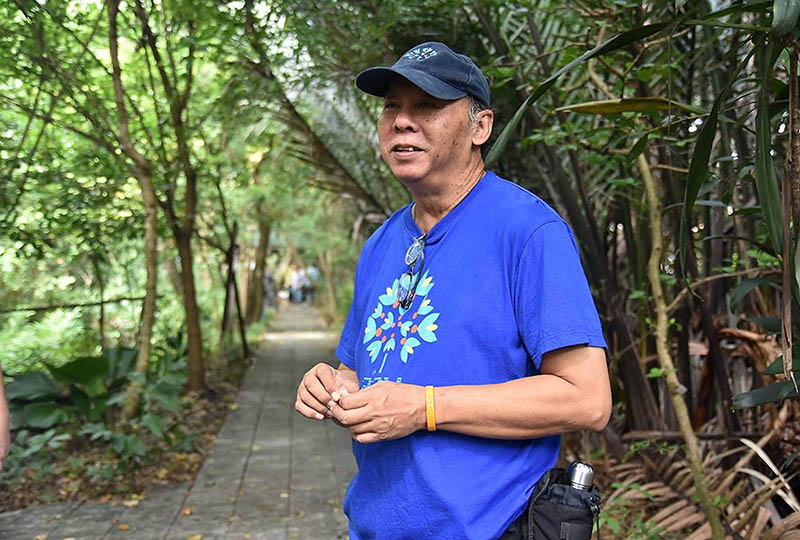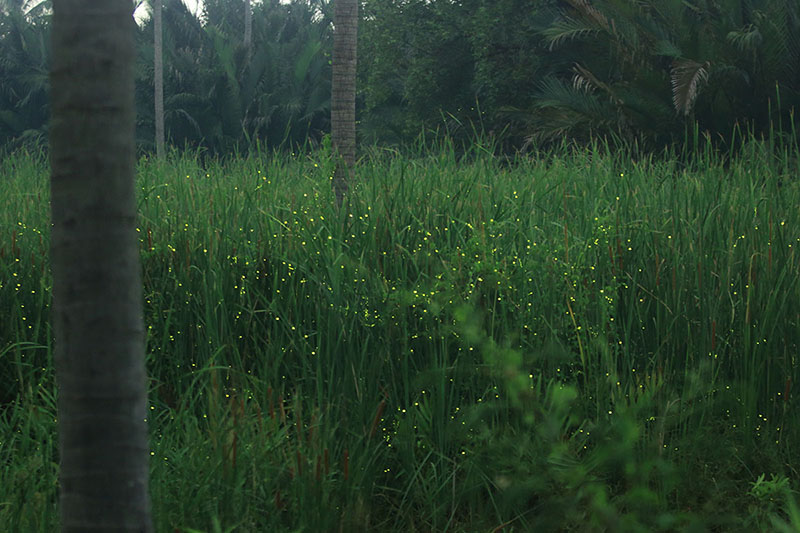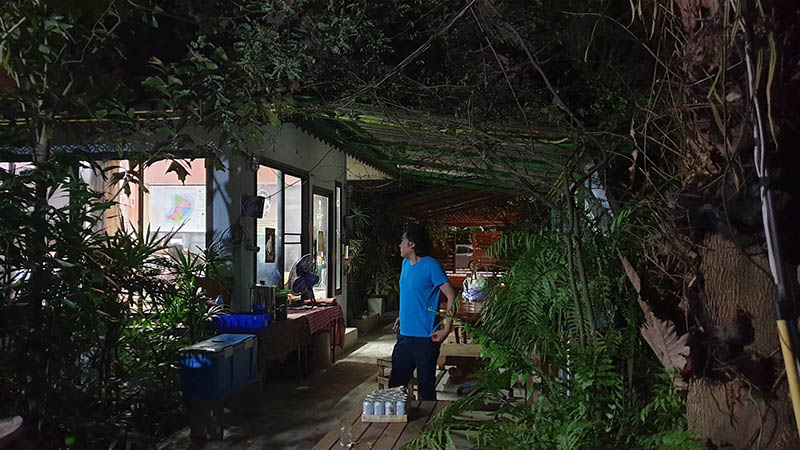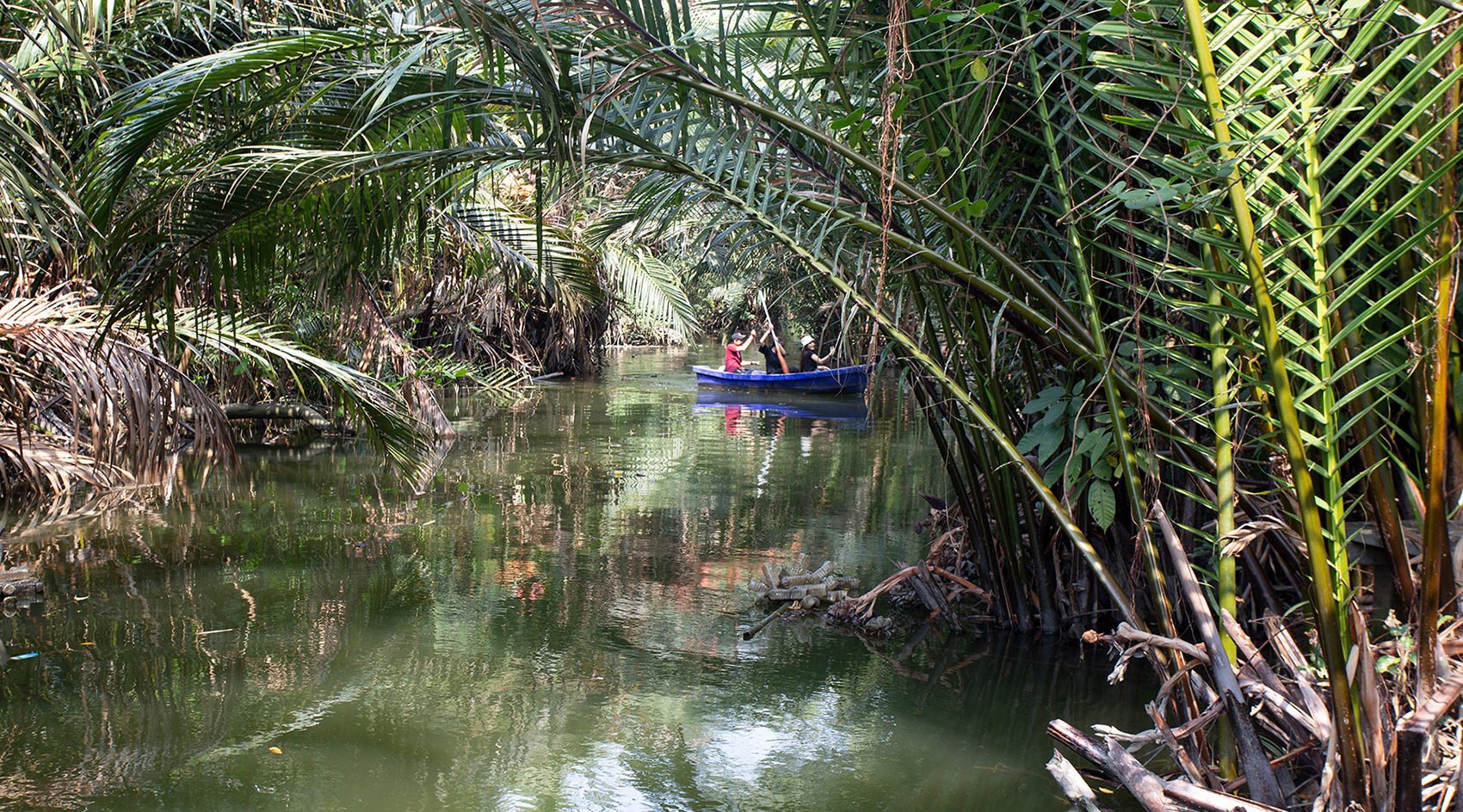One could be forgiven for describing Sukij Plubchang as the Don Quixote of Bang Krachao.
That’s because his dream is nothing less than saving the “river island” of his boyhood from overdevelopment and pollution by turning it into a glimmering haven for fireflies, something that doesn’t seem far-fetched when one observes thousands of tiny stars glowing in the undergrowth.
Fireflies are gradually returning to this natural haven, known as Bangkok’s “Green Lung.” Nestled in an oxbow bend of the Chao Phraya River across from the chaos of Bangkok’s concrete jungle, Bang Krachao is an oasis for nature-lovers and cyclists only a few kilometers from the capital’s business district.
There, one can learn about the marvels of a dynamic ecosystem that still exists close to the city but under threat from the inexorable pressure of population growth, construction and pollution. Visitors can learn about wildlife, nature and conservation while surrounded by forest and enjoying a meal of locally prepared delicacies.
Fireflies face extinction worldwide, partly due to light pollution’s eradication of darkness; something Bang Krachao still has — for now. Hoping to keep it that way, Sukij and his conservation group want to restore the “magic” of the place, where fireflies once flitted freely through its many mangrove apple trees, aka lamphu.

“I returned to my hometown at the age of 25 or 26, and I felt how special it was. Our back yard had many lamphu trees that glittered with fireflies like a miracle house of lights. No words could explain that beauty and magic at night!” he said. “Then suddenly they were gone. For two consecutive years they didn’t return, and I knew that something was wrong. Where did the fireflies go?”
So Sukij, who worked in the media and had no conservation background, invited his friends in the Amateur Photojournalist Club to help grow lamphu trees because they heard fireflies liked them.
“But when we waded down to plant the trees, oh my! We found that the problem was not the trees, it was the water which was rotten, dirty, and clogged up, causing it to stagnate,” he said. “We then started to work on making the water source clean, and we began to see fireflies every night for the past 10 years here.”
I first met Sukij scouting a trip for a friend’s birthday. At Wat Bang Na Pier, I hopped onto a ferry together with people returning home from work. We crossed from the city side over to Bang Krachao. The sketchy directions I’d received emphasized that I should mention to the motorcycle taxi on the other side to “take the orchard road” to the end of Soi Phet Chaheung 20.
There I encountered Sukij and heard his story of the island and his decade of work with nature conservation project Lumpoo Bangkasob to provide spaces for fireflies to reestablish and expand their numbers.
Day Tripper: Get some fresh air at Bangkok’s Green Lung
With sunlight streaming through the green canopy above us, we walked together among a jungle of tall trees and through the project’s learning center, while Sukij recounted his conservation journey.
Known as the “home of the fireflies,” the area is part of a government protected zone totaling 41 rai (6.6 hectares). It is surrounded by verdant jungle penetrated by nature-study pathways. There is a tall, elegant tree trunk hidden inside – a lamphu tree (to which fireflies are naturally attracted for courting, breeding, and raising their young) – is one of 63 trees over 100 years old in this heritage arboretum.
Fireflies could become a popular attraction that might also allow preservation to bring some financial rewards. While firefly tours have long been popular in Amphawa, about 90 kilometers west of Bangkok, the area has also been damaged by unmanaged and excessive tourism. Conservationists like Sukij are keen to avoid that mistake by carefully managing tourist numbers, so as not to disturb the environment in Bang Krachao.
He says his spot is the perfect place to bring them back.

“Khlong Lad Bang Yor, which is connected to this project is a tidal canal with the advantage of creating a natural diversity of nature. It means that if we can handle matters properly, the fluctuation of water will not interfere with the livelihoods of the villagers. It will allow us to live with biodiversity. It can become a symbol of revitalization and conservation. Bang Krachao might actually become a firefly island.”
We circled back to his house to find more local magic – his wife had already prepared inviting-looking dishes from local ingredients for our dinner. From my first slurp of kaeng liang (a mixed vegetable soup made with bases of black pepper, kapi and love) my mission of finding a meaningful place for a birthday party was fulfilled. It proved a special and meaningful destination to celebrate and share such wonders together.
Sukij has learned a lot about what makes fireflies romantic. For one, they like an open clear space so they can observe each other during mating rituals. The structure of their tree must not be dense, the more open the better. Because they breed in only the last two weeks of their short life cycle – just four months – the most important time of their lives is just before they die. To accomplish the conservation mission means not disturbing this crucial moment by creating opportunities and areas for reproduction.
In the early stages, Sukij said one of the activities he worked with the community on was counting firefly larva (their form before maturing) to measure the health of the environment and the number of firefly young.
“It’s not a job anymore, it’s a labor of love, that creates a strong bond among the group of people who come to do it together. Happiness comes when everyone reunites after counting the fireflies. Everyone will have a happy spark in their eyes from how many fireflies they have seen. We also put the soul of a person into the fireflies when we feel it in our consciousness.”
Despite his passion, Sukij’s and his fellow conservationists still face many challenges. While the impact of the global COVID pandemic may have slowed the economy, the respite may only be temporary. Bangkok’s developers are eyeing Bang Krachao hungrily as a new area of expansion, ripe for a fresh crop of housing estates and condominiums.

Reintroducing the fireflies requires planting trees and caring for the surrounding water environment all of which needs resources and cash. Though he has no government funding, Sukij does get some support from the likes of the Chaipattana Foundation and petrochemical giant Bangchak Corp., which supports the environmental protection area. Then there is the U.N. Development Programme, which paid for household grease traps to clean wastewater in various communities in the area.
All of these activities make it possible to see fireflies every night of the year, though the numbers depend on the season. “It’s been running for more than 10 years and things have been getting better and then worse again as a result of many factors, such as land development,” Sukij said.
Anyone can be part of the project to help protect the next generation of fireflies just by learning to live in harmony with the environment – whether riding a bicycle around the conservation area, learning about the use of leaves for tie-dyeing fabrics, making food, sampling local delicacies or just walking in the calm and quiet of the Lamphu Forest to see fireflies twinkle in the trees on a moonless evening, especially humid nights toward the end of the rainy season.
For more information or to book a visit, check out Lumpoo Bangkasob or call Khun Sukij at 08-8940-5992 (He speaks Thai best).


Nym Korakot Punlopruksa is an independent journalist and author who’s covered everything from coffee culture to international news events in media throughout Thailand and the world, the author of 25 international travel books, and the producer and host of programs that have aired in Voice TV and elsewhere. She can be reached at queenym@rocketmail.com.


